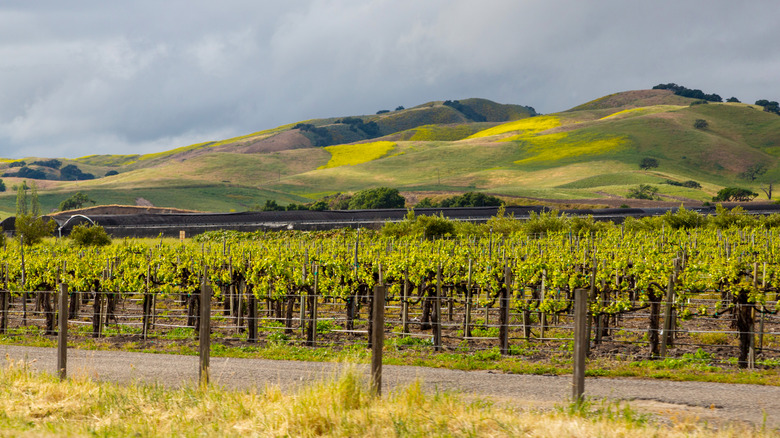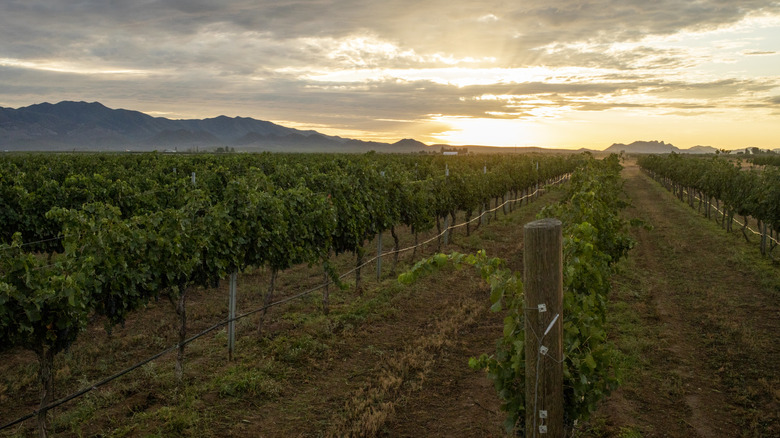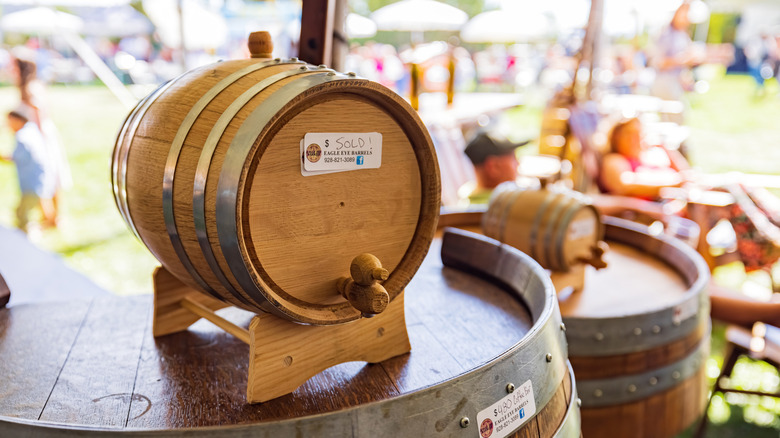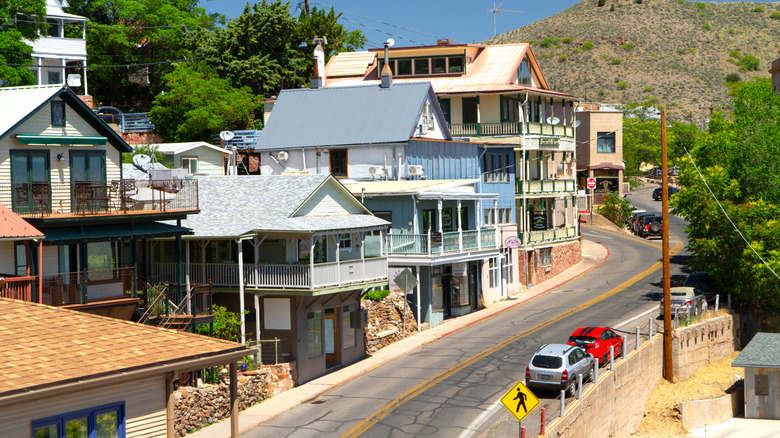Arizona's Under-The-Radar Wine Country Offers A Wide Range Of Complex, Bold Flavors
Arizona may be best known for its desert landscapes, stunning sunsets, and, of course, the Grand Canyon, but it's also an up-and-coming wine destination. Surprised? You're not alone. It seems contrary to logic, but Arizona's harsh climate — where daily air temperatures can rise or fall by 50 to 60 degrees Fahrenheit between day and night — is ideal for growing grapes for wines that can rival some of the best French and Italian varietals. Even the state's annual monsoon season contributes to its winemaking success. The temperature range, called a diurnal shift, coaxes grapes to mature with balance, maximizing sugar content while preserving aroma and acidity. Plus, Arizona's rocky landscape fosters the development of grapes with a noticeably complex flavor profile.
Here's how it works. During the day, when the air temperature is at its peak, the warmth promotes the development of sugars in the grapes. The cooler night air brings the process to a temporary stop, so the vines get a chance to rest between sugar cycles. The dramatic highs and lows result in grapes with just the right amount of acidity to produce wines with a noticeably fresh flavor profile. The dramatic daily temperature shifts also extend the growing season. A late harvest means more time on the vine for grapes to build flavor.
That's all well and good, but it begs the question, why did it take so long to figure out Arizona could produce good wine? Turns out, it didn't. In fact, Spanish settlers were growing grapes and producing wine in what is now the state of Arizona as far back as the mid-16th century. By the early 20th century, Arizona was producing more wine than California. What happened next? In a word, Prohibition.
Prohibition paused Arizona's burgeoning wine industry
The demise of Arizona's burgeoning wine industry wasn't immediate, but Prohibition — and its aftermath — took a huge toll on the once-promising endeavor. To complicate matters, Prohibition came early to Arizona. In 1915, local anti-liquor lobbyists successfully pushed through legislation forbidding the production and consumption of alcoholic beverages. This was a full five years before nationwide Prohibition took effect. The Arizona legislation happened so quickly that some vintners weren't even aware of the new law until they were found to be in violation of the act. Once Prohibition took hold, it so successfully wiped out Arizona wine production that almost 70 years passed from the time of the original state-wide ordinance in 1915 to the emergence of the first licensed post-Prohibition winery in 1982.
The roots of recovery began to take hold in 1970 when Dr. Gordon Dutt, a soil scientist familiar with Arizona's wine-making past, planted vineyards at locations around the state to monitor conditions and potential. Ten years later, in 1980, the results revealed in Dutt's "Four Corners Report" confirmed his theory about Arizona's suitability for wine growing. The report also posited that conditions southeast of Tucson were comparable to those in California's Sonoma County (which was, by then, established as one of the best U.S. destinations for wine tasting).
In 1982, the state granted Arizona native R.W. Webb a license to operate a commercial winery using grapes imported from California. Dutt, whose study jumpstarted the revival of Arizona's wine industry, also became a licensed vintner. His 1986 Reserve Cabernet Sauvignon earned recognition in 1989 when it made the wine list for George H.W. Bush's presidential inauguration. The Arizona wine industry was up and running again — until it wasn't.
Arizona's wine country is finally back in the spotlight
While Arizona's climate proved to be wine-friendly, the political landscape was not. Legislation governing the state's wine industry was so restrictive that, by 2000, only nine licensed wineries existed in the entire state. It was 2006 before restrictions were loosened enough to cultivate industry growth. By 2011, only 52 wineries operated across the state. That number had risen to 156 by 2024.
Today, Arizona is home to three distinct wine regions. Officially known as American Viticultural Areas, or AVAs, each federally designated region boasts a unique microclimate, elevation, terrain, and soil type. Arizona AVAs include the Verde Valley Wine Region, the Willcox Wine Region, and the Sonoita Wine Region. Each produces distinct wines, and all three are within driving distance of Tucson, Flagstaff, and Phoenix (PHX) — a major airport gateway to the region.
Located in southern Arizona about an hour south of Tucson, Sonoita is the state's first federally recognized AVA. The region's climate and terrain compare favorably to the Tuscany region of Italy — so much so that Soinita winemakers have co-opted the term garrigue, an adjective often used to describe the scrubby landscape found in drier Mediterranean regions, and applied it to local wines boasting a similar flavor profile, or Sonoran garrigue. In addition to its wineries and tasting rooms, the Sonoita Wine Region is also home to the towns of Patagonia (home to a vibrant arts community) and Sonoita (the site of Sonoita Creek State Natural Area and one of the most beautiful beaches in Arizona). Local wineries include Sonoita Vineyards (the state's oldest commercial vineyard, founded by 20th-century Arizona wine pioneer Gordon Dutt), Rune Wines (a solar-powered winery), and Callaghan Vineyards (opened in the mid-1990s as one of the state's first licensed wineries).
Explore Arizona's Verde Valley and wicked West history
Verde Valley in northern Arizona is about two hours north of Phoenix. At an elevation of between 3,000 and 5,500 feet, the terrain is rocky, and the sun is strong. The 714-square-mile region is known for its full-flavored syrahs and zinfandels. The Verde Valley Wine Trail connects several wineries including Alcantara Vineyards and Winery. The dog-friendly operation produces all-natural wines. It's also an all-around fun place where, in addition to tasting wines, activities include horseback riding, kayaking, and tubing.
Also on the wine trail, Pillsbury Wine Company is known for Rhone-style red wines like Roan Red, acclaimed for having pleasant berry notes. While you're in the region, be sure to visit Jerome, a historic site once known as the wickedest town in the West. Residents abandoned the communities here when local mines closed in the 1950s, but the area got a second chance when artists discovered the municipality. After teetering on the edge of becoming a ghost town, Jerome transformed into a thriving artists' enclave.
An hour east of Tucson, Arizona's Willcox Wine Region boasts a climate and terrain similar to France's Rhone Valley and Argentina's Mendoza Province. Using almost all Willcox-grown grapes, the region's vintners are known for producing a range of reds and whites in addition to sweet dessert wines. A federally designated AVA since 2016, the region's roster of wineries includes Four Tails Vineyards in the town of Pearce. A bonus: Getting there is half the fun. The scenic drive offers stunning views of Chiricahua National Monument, where natural rock formations reach hundreds of feet into the sky. If you're so inclined, the designated monument also features a network of hiking trails.



